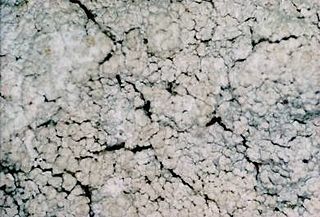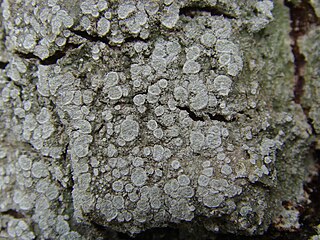
Lepraria is a genus of leprose crustose lichens that grows on its substrate like patches of granular, caked up, mealy dust grains. Members of the genus are commonly called dust lichens. The main vegetative body (thallus) is made of patches of soredia. There are no known mechanisms for sexual reproduction, yet members of the genus continue to speciate. Some species can form marginal lobes and appear squamulose. Because of the morphological simplicity of the thallus and the absence of sexual structures, the composition of lichen products are important characters to distinguish between similar species in Lepraria.
Alan W. Archer is a mycologist and taxonomist. He is currently an honorary research associate at Royal Botanic Gardens Sydney. He uses chemotaxonomy as well as morphological features in taxonomy and to devise keys, most recently for the genus Pertusaria in the Australasia region.
Pertusaria ambigua is a lichen in the family Pertusariaceae, and found in New South Wales, growing on trees.
Pertusaria guineabissauensis is a species of crustose lichen in the family Pertusariaceae. It was described as a new species in 2019 by Graciela Paz-Bermúdez, Alan Archer, and John Elix. It grows on tree bark, producing a thick greenish-grey thallus with a dull, wrinkled surface. The lichen is characterised by the presence of wart-shaped (verruciform) ascomata, asci that contain eight ascospores arranged in a single row (uniseriate) and the presence of the secondary chemicals stictic and hypostictic acids. The specific epithet refers to Guinea-Bissau, where the lichen was discovered, and its only known locality.
Pertusaria aptrootii is a species of crustose lichen in the family Pertusariaceae. It was described as a new species in 1998 by Alan W. Archer and John Alan Elix. The lichen occurs in Papua New Guinea, and is known from only two specimens collected at the type locality. The type was collected in Varirata National Park at an altitude of 800 m (2,600 ft), where it was found growing on conglomerate rock. It is named after Dutch lichenologist André Aptroot, who collected the type.
Pseudoparmelia kalbiana is a species of foliose lichen in the family Parmeliaceae. It is found in South America.

Salazinic acid is a depsidone with a lactone ring. It is found in some lichens, and is especially prevalent in Parmotrema and Bulbothrix, where its presence or absence is often used to help classify species in those genera.
Myelochroa salazinica is a species of foliose lichen in the family Parmeliaceae. Found in China, it was described as a new species in 2001 by Sheng-Lan Wang, Jian-Bin Chen, and John Alan Elix.
Phaeographis salazinica is a species of script lichen in the family Graphidaceae. Found in the Solomon Islands, the lichen was first described as a new species in 2003 by Australian lichenologist Alan W. Archer. He named it Phaeographis salazinica, with the specific epithet referring to the presence of the compound salazinic acid as its major secondary compound. The lichen also contains trace amounts of consalazinic acid, connorstictic acid, norstictic acid, subnorstictic acid, protocetraric acid, and methyl norstictate. The type specimen was collected near Tatamba on Tanabuli Island. The main morphological characteristics of Phaeographis salazinica are the conspicuous lirellae, and the large brown muriform ascospores. Archer transferred the taxon to the genus Phaeographis in 2007.
Psiloparmelia salazinica is a species of foliose lichen in the family Parmeliaceae. It is found in South America.
Xanthoparmelia salazinica is a species of lichen in the family Parmeliaceae. Found in South Africa, it was described as a new species in 1989 by American lichenologist Mason Hale. He classified it in Karoowia, a genus that has since been placed in synonymy with Xanthoparmelia following molecular phylogenetic analysis published in 2010.
Carbacanthographis salazinica is a species of script lichen in the family Graphidaceae. Found in Australia, it was described as a new species in 2001 by lichenologist Alan Archer. The type specimen was collected by Archer in Conglomerate State Forest. Here the lichen was found growing on the bark of a palm tree. Its thallus is thin and grayish-green, with conspicuous white lirellae measuring 1–4 mm long. The specific epithet refers to salazinic acid, the presence of which is a distinguishing characteristic of this species. The lichen also has trace amounts of other secondary chemicals, including consalazinic acid, norstictic acid, and protocetraric acid. In 2005 Archer transferred the taxon to genus Carbacanthographis.

Lepra is a genus of lichen-forming fungi in the family Pertusariaceae. Although the genus was created in 1777, it was not regularly used until it was resurrected in 2016 following molecular phylogenetic analyses. It has more than 80 species, most of which were previously classified in genus Pertusaria.
Hypogymnia australica is a species of foliose lichen in the family Parmeliaceae. Found in Australia, it was formally described as a new species by lichenologist John Elix in 1989. The type specimen was collected from the Great Dividing Range in New South Wales at an altitude of 850 m (2,790 ft). Here it was found growing on a species of Leptospermum.
Pertusaria epacrospora is a rare species of corticolous (bark-dwelling), areolate lichen in the family Pertusariaceae. Found in Australia, it was formally described as a new species in 1991 by lichenologist Alan W. Archer. The type specimen was collected in Park Beach at sea level; here, it was found growing on trees in a coastal sand dune. The lichen has a thin, pale yellowish-green thallus lacking soredia and isidia. It has numerous wart-shaped apothecia, the same colour as the thallus, which measure 0.4–0.8 mm in diameter and which have a single, inconspicuous ostiole. The ascospores, which number 2 per ascus, are smooth and fusiform (spindle-shaped), typically measuring 125–150 μm long by 35–45 μm wide. Pertusaria epacrospora is only known to occur at the type locality. Secondary compounds found in the lichen are thiophaninic acid and stictic acid as major components, and minor to trace amounts of constictic acid and hypostictic acid.
Buellia georgei is a species of lichen in the family Caliciaceae. Found in Australia, it was formally described as a new species in 2001 by lichenologists Ulrike Trinkaus, Helmut Mayrhofer, and John Elix. The type specimen was collected in Yanchep National Park ; here it was found growing on soft limestone. It has also been recorded from South Australia, New South Wales, and the Australian Capital Territory; preferred habitats are calcareous outcrops, on thin soil over limestone, or rarely on calcareous soil. The lichen produces some secondary compounds: arthrothelin as a major metabolite, and minor amounts of 4,5-dichloronorlichexanthone and thiophanic acid. The specific epithet honours Western Australian botanist Alex George.
Pertusaria sipmanii is a species of crustose lichen in the family Pertusariaceae. Found in Papua New Guinea, it was formally described as a new species in 1998 by Alan Archer and John Elix. The species epithet sipmanii honours Dutch lichenologist Harrie Sipman, who collected the type specimen.
Pertusaria pseudoparotica is a species of saxicolous (rock-dwelling), crustose lichen in the family Pertusariaceae. It is known from a few localities in Greece's Aegean Islands.
Xanthoparmelia micromaculata is a species of saxicolous (rock-dwelling), lichen in the family Parmeliaceae. Found in South Africa, it was formally described as a new species in 2002 by Australian lichenologist John Elix. The type specimen was collected from the summit of Waboomsberg mountain at an altitude of 1,220 m (4,000 ft). It is only known from the type locality. The lichen has a pale yellow-green, somewhat crustose thallus, reaching a diameter of up to 1 cm (0.4 in) wide. It contains several lichen products: stictic acid as a major metabolite, minor amounts of usnic acid, constictic acid, and hypostictic acid, and minor or trace amounts of norstictic acid, hyposalazinic acid, and cryptostictic acid. The species epithet refers to the prominent maculae on the thallus surface.


